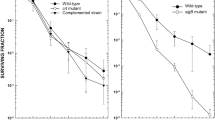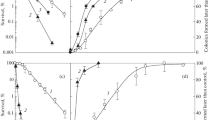Abstract
Strains of Staphylococcus aureus, an opportunistic pathogen commonly found on human skin, were exposed to sunlight and UV C radiation, and the lethal and mutational effects measured. Sunlight killed cells with an inactivation constant of 3×10-5 per joule per square metre; UV C was much more lethal, giving an inactivation constant of approximately 0.1 per joule per square metre. Some strains tested showed a sensitivity to sunlight that was dependent on the growth phase of the cells, exponentially growing cells showing a greater sensitivity. Mutational effects of irradiation were measured by the appearance of mutants sensitive to methicillin following irradiation of a multiresistant strain. Mutants appeared at a frequency of 10-3; this high frequency of mutation in the region of the mec gene has also been observed when multiresistant strains are subjected to nutritional or thermal stress. Mutants showed the same chromosomal alteration (seen in pulse-field gel electrophoresis of Smal-digested DNA) whether induced by solar or UV C irradiation.
Similar content being viewed by others
References
Billen D, Fletcher MM (1974) Inactivation of dark-repair-deficient mutants of Escherichia coli by sunlight. Int J Radiat Biol 26: 73–76
Brown E, Wenzel RP, Hendley JO (1989) Exploration of the microbial anatomy of normal human skin by using plasmid profiles of coagulase-negative staphylococci: search for the reservoir of resident skin flora. J Infect Dis 160: 644–650
Caldwell MM, Madronich S, Bjorn LO, Ilyas M (1989) Ozone reduction and increased solar ultraviolet radiation. In: United Nations Environment Program, Environmental Effects Panel Report, pp 1–10
Calkins J, Selby C, Enoch HG (1987) Comparison of UV action spectra for lethality and mutation in Salmonella typhimurium using a broad band source and monochromatic radiations. Photochem Photobiol 45: 631–636
Chang JCH, Ossoff SF, Lobe DC, Dorfman MH, Dumais CM, Qualls RG, Johnson JD (1985) UV inactivation of pathogenic and indicator microorganisms. Appl Environ Microbiol 49: 1361–1365
Eisenstark A (1987) Mutagenic and lethal effects of near-ultraviolet radiation (290–400 nm) on bacteria and phage. Environ Mol Mutagen 10: 317–337
Eisenstark A (1989) Bacterial genes involved in response to nearultraviolet radiation. Adv Genet 26: 99–147
Faergemann J, Larko O (1987) The effect of UV-light on human skin microorganisms. Acta Derm Venereol (Stockh) 67: 69–72
Favre A, Hajnsdorf E, Caldeirade Araujo A (1985) Mutagenesis and growth delay induced in Escherichia coli by near-ultraviolet radiations. Biochimie 67: 335–342
Guillobel H, Leitao AC (1988) Characterization of Staphylococcus epidermidis mutants sensitive to ultraviolet radiation. Mutat Res 193: 1–10
Hollaender A (1943) Effect of long ultraviolet and short visible radiation (3500 to 4900 Å) on Escherichia coli. J Bacteriol 46: 531–541
Inglis B, Matthews PR, Stewart PR (1988) The expression in Staphylococcus aureus of cloned DNA encoding methicillin resistance. J Gen Microbiol 134: 1465–1469
Inglis B, Heding I, Merrylees M, Stewart PR (1990a) Bacteriophage 604: a marker phage for multiresistant Staphylococcus aureus in Australia. Epidemiol Infect 104: 211–218
Inglis B, Matthews PR, Stewart PR (1990b) Induced deletions within a cluster of resistance genes in the mec region of the chromosome of Staphylococcus aureus. J Gen Microbiol 136: 2231–2239
Jagger J (1967) Introduction to research in ultraviolet photobiology. Prentice-Hall, Englewood Cliffs, New Jersey
Jagger J (1981) Near-UV radiation effects on microorganisms. Photochem Photobiol 34: 761–768
Lyon BR, Iuorio JL, May JW, Skurray RA (1984) Molecular epidemiology of multiresistant Staphylococcus aureus in Australian hospitals. J Med Microbiol 17: 79–89
Matthews PR, Inglis B, Stewart PR (1990) Clustering of resistance genes in the mec region of the chromosome of Staphylococcus aureus. In: Novick R (ed) Molecular biology of the Staphylococci. VCH Publishing, New York, pp 69–83
Matthews PR, Reed KC, Stewart PR (1987) The cloning of chromosomal DNA associated with methicillin and other resistances in Staphylococcus aureus. J Gen Microbiol 133: 1919–1929
Patel AH, Foster TJ, Pattee PA (1989) Physical and genetic mapping of the protein A gene in the chromosome of Staphylococcus aureus 8325–4. J Gen Microbiol 135: 1799–1807
Peak JG, Peak MJ, MacCross M (1984) DNA breakage caused by 334 nm ultraviolet light is enhanced by naturally occurring nucleic acid components and nucleotide coenzymes. Photochem Photobiol 39: 713–716
Peak MJ (1970) Some observations on the lethal effects of near-ultraviolet light on Escherichia coli, compared with lethal effects of far-ultraviolet light. Photochem Photobiol 12: 1–8
Robb FT, Hauman JH, Peak MJ (1978) Similar spectra for the inactivation by monochromatic light of two distinct leucine transport systems in Escherichia coli. Photochem Photobiol 27: 465–469
Roy CR, Gies HP, Elliott G (1989) The ARL solar ultraviolet radiation measurement programme. Transactions of the Menzies Foundation 15: 71–76
Silva BS, Leitao AC (1984) UV-induction of SOS responses in Staphylococcus epidermidis: characteristics of the process. Photochem Photobiol 39: 781–785
Sutherland JC, Griffin JP (1981) Absorption spectrum of DNA for wavelengths greater than 300 nm. Radiat Res 86: 399–409
Tam JE, Pattee PA (1986) Characterization and genetic mapping of a mutation affecting apurinic endonuclease activity in Staphylococcus aureus. J Bacteriol 168: 708–714
Thompson JK, Hart MGR (1981) Novel patterns of ultraviolet mutagenesis and weigle reactivation in Staphylococcus aureus and phage f11. J Gen Microbiol 124: 147–157
Thorington L (1980) Actinic effects of light and biological implications. Photochem Photobiol 32: 117–129
Tuveson RW, March ME (1980) Photodynamic and sunlight inactivation of Escherichia coli strains differing in near-UV sensitivity and recombination proficiency. Photochem Photobiol 31: 287–289
Tyrrell RM (1980) Mutation induction by and mutational interaction between monochromatic wavelength radiations in the near-ultraviolet and visible ranges. Photochem Photobiol 31: 37–46
Tyrrell RM (1985) A common pathway for protection of bacteria against damage by solar UV A (334 nm, 365 nm) and an oxidizing agent (H2O2). Mutat Res 145: 129–136
Tyrrell RM, Keyse SM (1990) New trends in photobiology (invited review); the interaction of UV A radiation with cultured cells. J Photochem Photobiol 4: 349–361
Tyrrell RM, Peak MJ (1978) Interactions between UV radiation of different energies in the inactivation of bacteria. J Bacteriol 136: 437–440
Walker GC (1987) The SOS response of Escherichia coli. In: Neidhardt FC et al. (eds) Escherichia coli and Salmonella typhimurium: cellular and molecular biology. Am Soc Microbiol, Washington DC, pp 1346–1357
Watson-Munro CN (1973) Report of the Committee on Solar Energy Research in Australia, 17. Australian Academy of Science, Canberra
Webb RB (1978) Near-UV mutagenesis: photoreactivation of 365-nm-induced mutational lesions in Escherichia coli WP2s. J Bacteriol 133: 860–866
Witkin EM (1976) Ultraviolet mutagenesis and inducible DNA repair in Escherichia coli. Bacteriol Rev 40: 869–907
Wyman L, Goering RV, Novick RP (1974) Genetic control of chromosomal and plasmid recombination in Staphylococcus aureus. Genetics 76: 681–702
Author information
Authors and Affiliations
Rights and permissions
About this article
Cite this article
Chapple, R.M., Inglis, B. & Stewart, P.R. Lethal and mutational effects of solar and UV radiation on Staphylococcus aureus . Arch. Microbiol. 157, 242–248 (1992). https://doi.org/10.1007/BF00245157
Received:
Accepted:
Issue Date:
DOI: https://doi.org/10.1007/BF00245157




